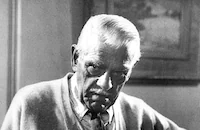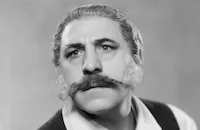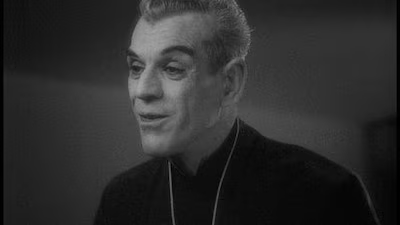The Black Cat

Brief Synopsis
Cast & Crew
Edgar G. Ulmer
Karloff
Bela Lugosi
David Manners
Jacqueline Wells
Lucille Lund
Film Details
Technical Specs

Synopsis
In Budapest, honeymooners Peter Alison, a mystery writer, and his wife Joan board a train bound for a resort near a small Hungarian town, and are joined in their compartment by Dr. Vitus Werdegast, a Hungarian psychiatrist. When the young couple falls asleep, Werdegast strokes Joan's hair, but Peter awakens and catches him in the act. Werdegast explains that eighteen years previously he left his wife to go to war, and has just returned from spending fifteen years in an infamous prison camp. When they disembark at the same town, the three share a bus, but just as the driver explains how the area had been Hungary's greatest battleground during World War I, the bus crashes and the driver is killed. On Werdegast's instruction, Peter carries an unconscious Joan to the fortress-like home of Werdergast's Austrian acquaintance, famed architect Hjalmar Poelzig. Poelzig has built his home on the ruins of Fort Marmorisch, which he once commanded. After Werdegast successfully operates on Joan, he accuses Poelzig of selling the fort to the Russians, who killed thousands of Hungarians. Werdegast also accuses Poelzig of stealing his wife while he was in prison, but their conversation is interrupted by the appearance of Peter and Joan. When a black cat enters the room, Joan's behavior becomes erratic, and Werdegast throws a knife at it and kills it. He then explains that cats are symbols of evil and, when they die, their evil goes into the nearest entity. Poelzig, however, counters that black cats are deathless and that Werdegast merely has a phobia. That night Poelzig takes Werdegast to a dungeon, where Werdegast sees, to his horror, the body of his wife, encased in a glass coffin. Poelzig explains that he loved her and also Werdegast's daughter, Karen, who died of pneumonia two years after the war. Werdegast is enraged and attempts to kill Poelzig, but suddenly cowers when a black cat appears. Later, while Poelzig secretly visits Karen, who is alive and is his wife, Werdegast plots the murder of Poelzig with his manservant, Thamal. Werdegast realizes that Poelzig plans to keep Joan captive, and the two men compete in a game of chess to determine her fate. They are temporarily interrupted by the police, who are investigating the bus accident, and Poelzig mollifies them by promising to drive the Alisons to the train that night. Peter is alarmed, however, when he discovers that the car is out of commission, his gun is missing and the phone is dead. When Werdegast loses the chess game, Thamal holds Peter and Joan hostage in separate rooms, but Werdegast secretly reveals to Joan that Thamal is still working for him, and is obeying Poelzig's orders until the time is right to kill him. Joan is surprised by the appearance of Karen, who believes that her father is dead. When Poelzig hears Joan tell Karen the truth, he takes Karen into another room and kills her. Soon, guests arrive for a cult ceremony in which Poelzig, who is the high priest, intends to sacrifice Joan. When one of the guests faints, there is a commotion during which Werdegast and Thamal help Joan escape downstairs. Peter tries to escape but is knocked unconscious by one of Poelzig's servants. After Werdegast finds Karen's body, he and Thamal handcuff Poelzig and hang him by his arms, after which Werdegast proceeds to skin Poelzig alive. Peter revives and, hearing Joan's horrified screams, comes to her rescue. When he sees Werdegast trying to help Joan get the door key out of Poelzig's hand, he misinterprets Werdegast's attempt to help and shoots him. As Peter and Joan escape, Werdegast pulls a lever that sets off explosions destroying Marmorisch. Outside, Peter and Joan escape unharmed and flag down a car. Later, on a train headed for Budapest, Peter reads a review of his newest thriller, in which the reviewer discounts the credibility of the story.

Director

Edgar G. Ulmer
Cast

Karloff

Bela Lugosi

David Manners

Jacqueline Wells
Lucille Lund
Egon Brecher

Harry Cording

Henry Armetta
Albert Conti
Anna Duncan

Herman Bing
Andre Cheron
Luis Alberni
George Davis
Alphonse Martell
Tony Marlow
Paul Weigel
Albert Pollet
Rodney Hildebrand
Peggy Terry
Lois January
Michael Mark

John George
Duskal Blane

King Baggott

Peter Richmond
Harry Walker
Symona Boniface
Virginia Arnsworth
Crew
E. M. Asher
Johann Sebastian Bach
Ludwig Van Beethoven
Ray Curtiss
Paul Dukas
Roman Freulich
John P. Fulton
King Gray
Charles D. Hall
Moree Herring
Tom Kilpatrick
Carl Laemmle
Carl Laemmle
John Martin
John J. Mescall
M. F. Murphy
Giovanni Pierluigi Da Palestrina
W. J. Reiter
Heinz Roemheld
Peter Ruric
Peter Ruric
Edgar G. Ulmer
Peggy Vaughn
Sam Weisenthal

Videos
Movie Clip



Hosted Intro
Film Details
Technical Specs

Articles
The Black Cat (1934) - The Black Cat (1934)
So confident was Laemmle that he allowed the ambitious Ulmer virtually free rein on the picture. Ulmer responded by crafting a story from scratch with screenwriter Peter Ruric, casting aside three different Black Cat treatments already sitting in the script department, as well as Poe's story itself, retaining only a mere trace of the original text. "The Edgar Allan Poe story is not a story you can dramatize," said Ulmer frankly.
While Ulmer may have been afforded creative freedom in making The Black Cat, Universal kept him on a short leash nonetheless. The film was budgeted at a third of what the studio had spent on Dracula (1931) or Frankenstein (1931), and allowed a brief fifteen-day shooting schedule. Because Ulmer had a genius for crafting ambitious films on incredibly low budgets, The Black Cat looks as though it cost twice as much as it did.
Ulmer's background was primarily as a set designer. Working in the German theatre circa 1910, and under legendary stage director Max Reinhardt, Ulmer carried his skills to the cinema, collaborating with Fritz Lang and F.W. Murnau on such classics as Metropolis (1927) and Sunrise (1927). As a director, he had found few opportunities in America, making a series of low-budget silent Westerns for Universal, and a syphilis education film for the Canadian Social Health Council. Ulmer knew that The Black Cat was his golden opportunity.
Rather than exploring the 1843 tale of psychological disintegration, Ulmer looked for inspiration in the horrors of the recent past. While working on The Golem (1920) in Germany, Ulmer met novelist Gustav Meyrinck, who "was contemplating a play based on Doumond, which was a French fortress the Germans had shelled to pieces during World War I; there were some survivors who didn't come out for years," explained Ulmer in a 1970 interview with Peter Bogdanovich. "And the commander was a strange Euripedes figure who went crazy three years later, when he was brought back to Paris, because he had walked on that mountain of bodies."
Thus Ulmer found his Poe-worthy setting: Castle Poelzig, built atop the bloodstained ruins of Fort Marmaros. Early in the film, a pair of newlyweds (David Manners and Jacqueline Wells) journey through the stormy Hungarian countryside in the direction of Poelzig's lair. Like a morbid tour guide, the taxi driver proudly describes the surrounding battlefield, "tens of thousands of men died here. The ravine down there was piled twelve deep with dead and wounded men. The little river below was swollen, red, a raging torrent of blood." Immediately thereafter the car swerves off the road and the taxi driver himself joins the army of the dead, while the travelers venture on foot to the imposing Castle Poelzig. Journeying with them is Dr. Vitus Verdegast (Lugosi), who is a survivor of the bloody Marmaros battlefield upon which they tread. When they arrive at the mountaintop mansion, Verdegast recognizes Poelzig (Karloff) as a bloodthirsty officer in the war. Within the walls of Castle Poelzig a mental battle ensues, a murderous game of chess in which the young lovers are used as pawns by the sinister Poelzig and vengeful Verdegast.
This might appear to be the typical dark-and-stormy-night drama but at the moment when the weary travelers ring Poelzig's doorbell, The Black Cat dramatically upends the conventions of the typical "Old Dark House" thriller. Instead of the gloomy, stone-walled castle, they find themselves in a sleek mansion of glass bricks, a stainless-steel staircase, chrome fixtures and neon lights. "It was very much out of my Bauhaus period," Ulmer dryly explained.
As a production designer, The Black Cat is Ulmer's greatest achievement. Poelzig's castle is a masterpiece of 1930s Deco architecture, designed to mirror the icy detachment and steely demeanor of its lord. The Karloff character was named in tribute to one of Ulmer's architectural mentors, Hans Poelzig, who supervised Ulmer's work on The Golem. To a degree, Karloff's performance was also governed by Ulmer's ultra-modernist vision. Gowned in silky black robes, his hair combed and shaved into sharp angles, he moves stiffly, almost robotically through the gleaming halls. When the character is first introduced, lying in bed with his unconscious bride, the script indicates, "the upper part of a man's body rises slowly, as if pulled by wires, to a sitting position." Karloff scoffed at this mechanical approach to performance. "Aren't you ashamed to do a thing like that," he asked Ulmer, "that has nothing to do with acting?" Ulmer persisted and as a result Karloff gives one of the most understated yet unsettling performances of his career.
Lugosi, meanwhile, occupied the opposite extreme, having a tendency to overact that was only exaggerated by his thick Hungarian accent. Ulmer cleverly moderated Lugosi's performance by limiting his screen time, focusing more on reaction shots of other characters. "You had to cut away from Lugosi continuously," Ulmer said, "to cut him down."
Supporting actor David Manners was another Universal horror veteran, though one of a lower profile. Manners had played the straight man in such cornerstone shockers as Tod Browning's Dracula and Karl Freund's The Mummy (1932), and reprised his role as the handsome young man trying to protect his bride from evil incarnate.
The Black Cat was produced shortly before the Production Code tightened its reins on the motion picture industry, at a time when clever filmmakers could still weave a surprising amount of adult material into a film if they exercised a subtle touch. Even under these somewhat liberal circumstances, it is mind-boggling how many diabolical flourishes Ulmer heaped into this mere 65-minute film. The film climaxes as a group of worshipers arrive at Poelzig's castle to participate in a black mass during which Joan is to be sacrificed on an altar of Satan. Interrupting the proceedings, Verdegast lashes Poelzig to his own torture rack and skins him alive with a small knife.
When the first cut of The Black Cat was screened for the Laemmles (studio head Carl Sr. and producer Carl Jr.), they were shocked by the horrors Ulmer had created. Lugosi, meanwhile, expressed angry disappointment to find that once again he was playing a villainous character, exhibiting some of the same murderous and lustful urges of the evil Poelzig. Ulmer grudgingly agreed to reshoot certain scenes, downplaying the brutality of the "skinned alive" sequence, and making Verdegast more of a protector of Joan's virtue than a threat to it. Rather than being discouraged and bitter by the imposed changes, the crafty Ulmer took advantage of the extended shooting schedule to add a few new scenes, including the film's most perverse sequence. In the underground dungeon -- the stony depths of the old Fort Marmaros -- Poelzig leads Verdegast on a tour of his trophies: a series of beautiful women, dead, embalmed, exquisitely posed in glass display cases. It was never obvious to the studio brass, but in addition to being a sadist and Satanist, Poelzig was also a necrophile.
Upon its release, The Black Cat turned out to be the highly profitable "sure thing" Ulmer had promised. One would expect the director to be generously rewarded for his efforts but the film instead almost ended his career -- but not for reasons that are readily apparent. His script assistant on the set was Shirley Castle Alexander, who was married to one of Laemmle, Sr.'s favorite nephews, Max Alexander. Ulmer and the script girl fell in love during production and Shirley soon left her husband for the mysterious and intellectual filmmaker. When Edgar and Shirley were married, they had no choice but leave Hollywood, where Ulmer felt he would be professionally blackballed. They moved to New York and began a career making independent features on extremely small budgets, including Yiddish films (Green Fields, 1937), a black cast film (Moon Over Harlem, 1939), a film for Ukrainian immigrants (Cossacks in Exile, 1939) and melodramas (Girls in Chains, 1943). Banished to a B-movie purgatory of low-end studios, laboring under financially restrictive circumstances, Ulmer still managed to flourish artistically, savoring the freedom to experiment that the studio system seldom allowed.
Producer: Carl Laemmle, Jr.
Director: Edgar G. Ulmer
Screenplay: Peter Ruric, "Suggested by" the story by Edgar Allan Poe
Cinematography: John Mescall
Production Design: Edgar G. Ulmer
Music Supervisor: Heinz Roemheld
Principal Cast: Boris Karloff (Hjalmar Poelzig), Bela Lugosi (Vitus Verdegast), David Manners (Peter Alison), Jacqueline Wells (Joan Alison), Harry Cording (Thamal).
BW-66m.
by Bret Wood

The Black Cat (1934) - The Black Cat (1934)
Quotes
The phone is dead. Do you hear that Vitus? Even the phone is dead.- Hjalmar Poelzig
I don't know. It all sounds like a lot of superstitious baloney to me.- Peter Allison
Superstitious, perhaps. Baloney, perhaps not. There are many things under the sun.- Dr. Vitus Verdegast
Come Vitus, are we men or are we childrens ?- Hjalmar Poelzig
Trivia
Boris Karloff's character is named after Austrian architect and set designer Hans Poelzig.
The satanic prayer Poelzig chants during the black mass scene consists of phrases in Latin, the most recognizable being "cum grano salis" (with a grain of salt).
Edgar G. Ulmer admitted in an interview that Edgar Allan Poe's story was credited to draw public attention, despite the fact it had nothing to do with the story in the movie.
Censors in Italy, Finland and Austria banned the movie outright, while others required cuts of the more gruesome sequences.
This was Universal's biggest hit of 1934.
Notes
According to production files at the USC Cinema-Television Library, the film's final cost was $95,745.31. The MPAA/PCA Collection at the AMPAS Library reveal that many scenes were considered objectionable due to sexual suggestiveness and "gruesomeness," in particular the scenes in which Poelzig is flayed and in which the cat is killed. Included in the suggestions by the Hays Office of things to change or delete were a scene of a cat licking blood on Joan's shoulder; the original opening scene of a wedding; the appearances of corpses; the suggestion of German nationality of the people attending the ceremony; the suggestion that the ritual was a parody of an actual religious ceremony; any sexual intimacy or hint of homosexuality; and references to Czechoslovakians in which they were described as "people who devour the young." Although New York, Kansas, Massachusetts and Pennsylvania state censors approved the film without deletions, Ohio, Ontario, Chicago, Quebec and Sweden all required the deletion of the flaying scene. Great Britain (where the film was titled The House of Doom) and Japan released it with further deletions. The film was rejected by censors in Italy, because "it could create horror," in Finland and in Austria, because it portrays an Austrian as a "military traitor and main criminal, thus offending the national feeling of the people." When the picture was re-issued in 1938, the Hays Office granted it certification.
This was the first film in which Boris Karloff and Bela Lugosi appeared together. In a modern interview with Peter Bogdanovich, Edgar Ulmer confirmed that although the film had little connection to the Edgar Allan Poe story, the credit to Poe was retained to draw public interest. According to a modern source, E. A. Dupont was slated to direct the initial project, based on a script drafted by Tom Kilpatrick and Dale Van Every, which was shelved by Universal due to financial problems of the studio. In 1934, Ulmer wrote a different draft of the story, which was expanded into a screenplay by Peter Ruric. Kilpatrick later wrote continuities for The Black Cat, and was assisted by script clerk Shirley Kassel, who married Ulmer a year later. Modern sources also note that Poelzig's home was painted on glass by Russ Lawson and was photographed by Jack Cosgrove. Modern sources credit Jack Pierce with make-up and include Paul Panzer and Herman Bing in the cast, although Bing's appearance as a maitre d' in the beginning of the film was cut from the final print. The film was re-issued in 1953 as The Vanishing Body. In addition to many other features based on Poe's story, in 1941 Universal released The Black Cat, based on the same source, although the plot differs markedly from the original. It was directed by Albert S. Rogell and starred Basil Rathbone, Hugh Herbert, Broderick Crawford and Bela Lugosi.

















